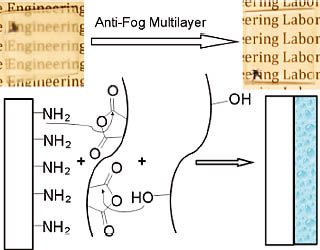Permanent Anti-Fog Visor Coating
First Permanent Anti-Fog Coating Developed
UPDATE: RIA2 permanent anti-fog coating review!
Dr. Laroche and his colleagues present in the online edition of Applied Materials and Interfaces the details of this innovation which could eliminate, once and for all, the fog on eyeglasses, windshields, goggles, camera lenses, and on any transparent glass or plastic surface. As every motorcyclist knows, fog forms on a surface when water vapor in the air condenses in fine droplets.
“Despite appearances, the fog that forms on glasses is not a continuous film. In fact, it consists of tiny droplets of water that coalesce on the surface and reduce light transmission” explains Laroche, a professor at Université Laval’s Faculty of Sciences and Engineering. “A good anti-fog coating should prevent the formation of such droplets”.
Researchers used polyvinyl alcohol, a hydrophilic compound that allows water to spread uniformly. The challenge was to firmly attach the compound to the glass or plastic surface.
To accomplish this, researchers applied four successive layers of molecules, which formed strong bonds with their adjoining layers, prior to adding the anti-fog compound over this base. The result was a thin, transparent, multilayered coating that does not alter the optical properties of the surface on which it is overlaid.
In addition, the chemical bonds that join the different layers ensure the hardness and durability of the entire coating.
“Existing anti-fog treatments don’t have these properties and won’t withstand washing, so the product application must be repeated regularly” notes Professor Laroche. “Our coating, on the other hand, is permanent”.
Two patents already protect this invention, which has numerous potential applications, including vehicle windshields, protective visors, camera lenses, binoculars, optical instruments used in chemistry and medicine, and corrective lenses.
Negotiations are already underway with a major eyewear company interested in obtaining a license for this technology.
In addition to Gaétan Laroche, the study published in Applied Materials and Interfaces was coauthored by Pascale Chevallier, Stéphane Turgeon, Christian Sarra-Bournet, and Raphaël Turcotte.
For more information, contact Gaétan Laroche Faculty of Sciences and Engineering Université Laval 418-656-7983 Gaetan.Laroche@gmn.ulaval.ca
Source: Jean-François Huppé Media Relations Université Laval 418-656-7785 Jean-Francois.Huppe@dc.ulaval.ca


